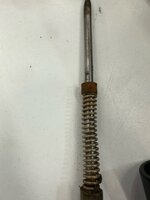West2East
Lil-Rokslider
Tikka T3x Lite 6.5cm: I tried to run my firing pin dry after cleaning with brake clean like the first post. After about 50 dry cycles and 20 dry fire practice shots indoors, I got a noticeable heavy lift and it felt like in the cocking motion. I pulled the firing pin and put a dot of olive oil on my gloved finger and spread that all over the spring and upper pin and plunging it a few times. After doing this, the bolt lift returned to normal.
I do notice that now I have a chatter (probably in the last 20 firings) when running the bolt to the rear and forwards, and I'm seeing a wear line on the bolt body which appears to be from the rear of the action.
Would you expect this to wear down after a bit or is this something where I put too little oil on, too much? I have around 350 rounds through the gun and probably around the same in dry cycles.
Edit to add: I live in coastal Oregon, shooting on the coast and over east where it is drier
I do notice that now I have a chatter (probably in the last 20 firings) when running the bolt to the rear and forwards, and I'm seeing a wear line on the bolt body which appears to be from the rear of the action.
Would you expect this to wear down after a bit or is this something where I put too little oil on, too much? I have around 350 rounds through the gun and probably around the same in dry cycles.
Edit to add: I live in coastal Oregon, shooting on the coast and over east where it is drier




